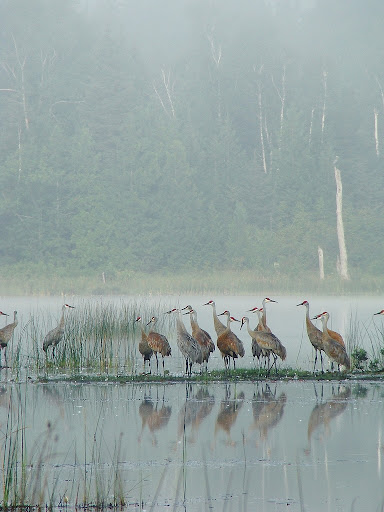 |
| Grus canadensis, Sandhill Cranes on the lake |
“I’m not sure if this is related to the [study of] environment …” said a colleague with a shrug. I was talking about the project I assisted for in the past two months. According to him, studying Sandhill Crane study is not a part of environmental studies, or I may simply say wildlife study is not related to environmental studies. So what is environmental studies – is it sitting in the labs measuring the amount of Carbon dioxide in the air, or the amount of heavy metals in the water, or environmental policies and laws that we study in our class? I never had to answer this question. Because I never separated these aspects of environmental studies from nature. A talk with the colleague revealed a great wisdom of academic knowledge, but he failed to impress me with his words I repeated above. I think, and I hope I am wrong, that he forgot what environmental studies is for – it is not for the sake of the pollutant we discover in air or water, it is for the sake of the air and water. Likewise, wildlife studies is not for the sake of a biologist – but for the sake of the environment. This is environmental studies, where wildlife, chemistry, physics, geography and literature are studied unbiased. Any imbalance and it is bound to take a toll on the way we define environment. I learnt about the environment more in the field than what I did in a classroom. I am going to talk about my observations here.
It was two months ago that I set out on a trip to Manitoulin Island. I have heard of this place before, but I never imagined I would ever have a chance to work there. It is the largest island surrounded by fresh-water in the world. I know I was going to assist on a project on Sandhill Cranes, where we had to capture, handle and assist in attaching GPS transmitters on the cranes. What I did not know, was that I was given an opportunity to study, observe, nurture my hobby of photography and learn to be patient. During the period of this study, it was not only Sandhill Cranes I had the opportunity to stare at for hours, but the diverse flora and fauna of the island, which I will discuss in the end.
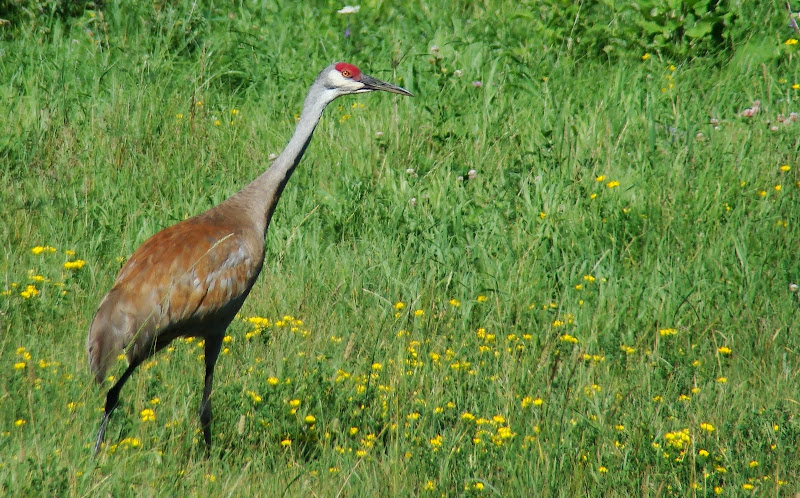 |
| An adult Sandhill Crane |
Grus canadensis [Sandhill Crane] is a large bird, and you would know for sure once you see it. Although not as threatened as its cousin
Grus americana [Whooping Crane], it was once hunted down to near extinction. Now due to restrictions on hunting as well as conservation measures taken in time, they are thriving throughout Canada – so much so that they are often given the status of a pest in some areas. But this success story does not hold true for
G. americana. In this regard, Sandhill cranes were used as foster parents for Whooping Crane hatchlings, which however failed, since Whooping Cranes did not recognize other Whooping Cranes as their conspecifics. Yet, it was worth the try.
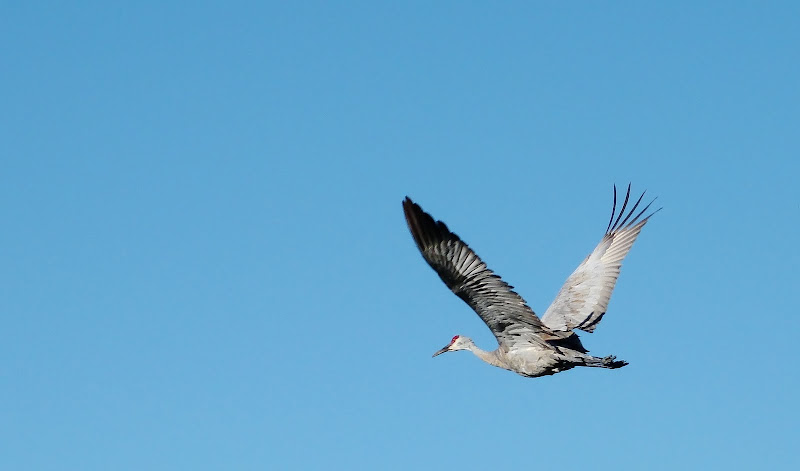 |
| Sandhill Crane in flight |
An adult Sandhill Crane will stand about three to four feet tall, and weigh nearly four to five kilograms. This bird, as large as it is,
is also highly social, which is significant enough to call it an intelligent bird. But that’s not all. This bird is indeed very smart – because it has the ability to communicate – whether it is with a human or a coyote, or with a hatchling. This communication is not only about fear, fight or flight – as it is for all animals, but it is rather complex involving subtle interactions between each other, like that between social animals. I had the chance to observe these birds for hours at an end. During the period of July and most of August, I and my colleagues were able to interact with these birds. To trap birds, we need to understand them well – and to understand a bird, one must understand where it feeds. This helped us target certain farmlands, but the next problem was to bring them closer to the rocket-nets. We baited corn and barley near the nets, and waited. And waited. One week. Two weeks.
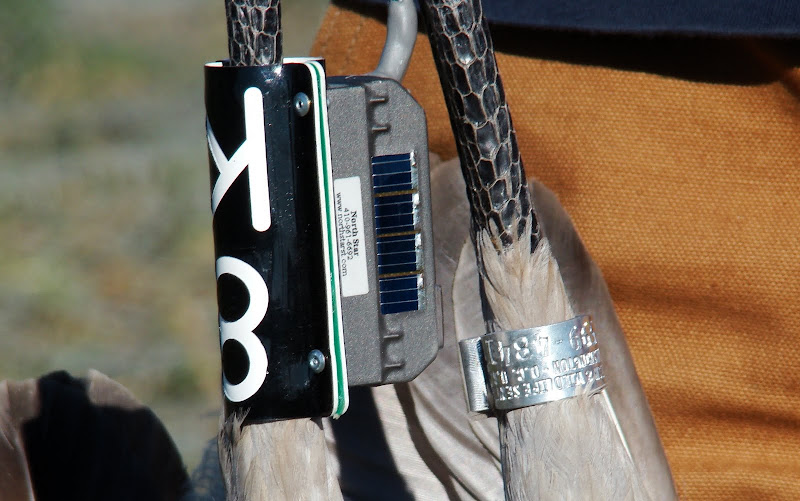 |
Sandhill Crane with a GPS and bird-band ready to be released. For our safety we had to hold them upside down.
The birds were not harmed at all. |
On the first day of the third week, we caught one crane, tagged and released. This was a great achievement for us, but I would not say that the two weeks were wasted. Besides catching up on sleep while in the hideout, I also woke up to a Garter Snake sneaking inside by shirt, a skunk walking unknowingly into our blind, a field mouse that would sneak out from under the leaf litter and other bugs that I just adore. In these two weeks, and many other weeks where we observed absolute silence – only moving when there are more mosquitoes biting you than you can tolerate, we had to, literally, be one amongst the trees. Always watching. And by watching (and hearing), I learnt much about these cranes – a simple method used by field biologists for years.
 |
| At the roosting site |
Sandhill Cranes are flamboyant hence failing to see them is hard, except if they are hatchlings, which are pretty good at camouflaging in the grasslands. This magnificent bird flaunts a ruby-colored crown, and a smear of rusty bronze adorns its otherwise fair feathers. The legs are dark in color, slender and tall – an efficient adaptation similar to every other bird associated with wetlands and grasslands. These legs are strong, capable of piercing flesh or causing a nasty gash if handled carelessly. The males and females are often difficult to tell apart, but often it is the males who are larger, and weigh more. If you see a pair of Sandhill Cranes flying, most often it is the males who lead; female follows slightly behind and then follows the immature crane. I am not sure who leads the flock of cranes, but my guess would be a male – for reasons similar to why a male leads the way in the pair. This is perhaps because the male is elder, knows more about the landscape, and is bolder (Bolder in the sense that a female has to incubate the egg, hence has to be more careful). Or perhaps, it is not always the male. An elder female crane might know just as well where to feed and to roost, hence this is debatable. In wild, telling a male and female might be difficult, but generally, if a bird appears larger than its counterpart, it is probably a male. Sexing these birds is difficult hence scientists have developed a method to make a concrete guess – by measuring the bodyweight, tarsal length, wing-cord length and the culmen length. [If the length is longer than the partner, then it’s a male.]
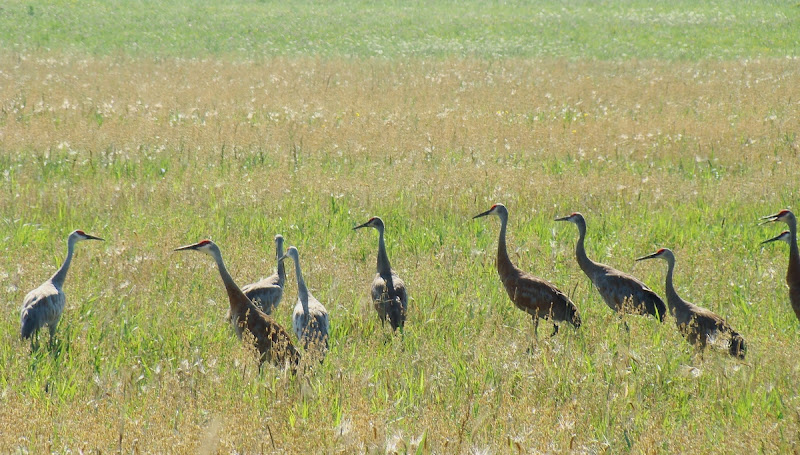 |
| Sandhill Cranes, when alarmed, raise their heads and often walk while moving their head forward and backwards |
These birds behave similar whether it’s a pair or a flock. It is always one of them who is watching – always cautious – as the others feed. This is an efficient way to feed, no doubt, given how weary these birds can be. But one alarm from the watchman and all the heads turn up. There is an awkward silence, like a lull before the storm as they watch intently. And then they call in chorus, like the trumpets ringing before a battle. This behavior is so fascinating, that I froze in awe and wondered if they saw me. Generally, they are very weary, hence slightest movement, whether it’s a falling branch or a coyote will turn their heads. Another behavior we observed was their response to the bait. Why wouldn’t you lure in, if you see a basket full of muffins and berries, if you like them? Similar question haunted us on our stay, since the cranes never looked interested in the pile of corn lying in the middle of a field. It was perhaps because they thought it was a mirage? No, but probably because they saw the camouflaged net lying next to the pile. Yet, there were cranes that happened to feast on this bait, but the chances were very low – which surprised us. When we observed more closely, it all depended on the alpha-male/female, who would – at first – cautiously close-in on the bait. Often they did not, and so didn’t the other cranes. This gives us an idea of how the social system of Sandhill Cranes is shaped, comparable to that of elephants and wolves.
You don’t always have to see these birds, since only listening to them can provide a great deal of information. They sound like trumpets, with every tune expressing a different mood. I was startled when I first heard them – so loud, so cheerful. After a few weeks, we learnt how to decipher them – and it’s easy. When we were hiding in our hideouts, I often could not see the cranes, but their presence was always known – thanks to my friends’ running commentary! But that’s not all; it was the cranes that made their presence felt. That loud flapping of wings as they swooped past our hideout in early mornings, that loud, shrill call – welcoming the morning sun. It was all a beyond-normal experience. These cranes talk. And they talk smart. We found this out by listening to them – and now we can tell when they are happy, alert or sad, we can also tell when a mother is calling for her baby, or a baby calling for its parents.
As interesting as it is, it is not difficult like song-birds at all. I was not surprised to decipher their language – to an extent – but after I came back, I hit the search button on Google and it produced several searches – some of them about the study of Sandhill crane calls. After going through it, I was surprised that I was right! They did speak a language that I understand! This was an achievement, personally, since I have never studied any animal so closely before that can talk.
In summary, the calls of the cranes are quite distinct. When they are happy, they give out a gallant call, mostly accompanied with flapping of wings, jumping, and chasing each other. When they are alarmed, they freeze – call in a high pitched tune at a random. This alarm call is comparable to the chorus of monkeys, when they sense danger – or that of wolves, when they howl. All of these animals do not call in unison, although they call together. They call one after the other, at different times using different tunes – this perhaps makes them seem to be greater in numbers, which might startle and intimidate the predator [but in case of wolves, it is a warning call for the neighboring clan]. When caught, which I consider to be their “sad” mood, they give out a gurgling call. The juvenile cranes call is rather different than the adult. The call is sweet, song like and pretty loud to catch the attention of the parents.
 |
| The eye of a majestic crane |
All of this, within a span of seven weeks has taught me a lot about the ecology of Sandhill cranes. Unfortunately, I did not observe their mating behavior, since it was not the season, hence I will omit it, but it is worth observing for any species of Crane. Now I will tell you why these birds are pests. Pest is a status given when an organism causes economic damages. Whether it’s aphids, caterpillars, amphibians, birds or mammals. Sandhill Cranes are considered pests – in some parts – because they feed excessively on crops like barley and oats. The damages are economically extensive, driving the farmers crazy. For this reason, the government has granted permission [in the form of licenses] to hunt the cranes. The farmers usually are ignorant to the plight of this bird, but they shoot in order to save the crop. I am not against this, since they do damage the crops, and there needs to be some regulation, but how many are we going to shoot? This, apparently, is not addressed by the government.
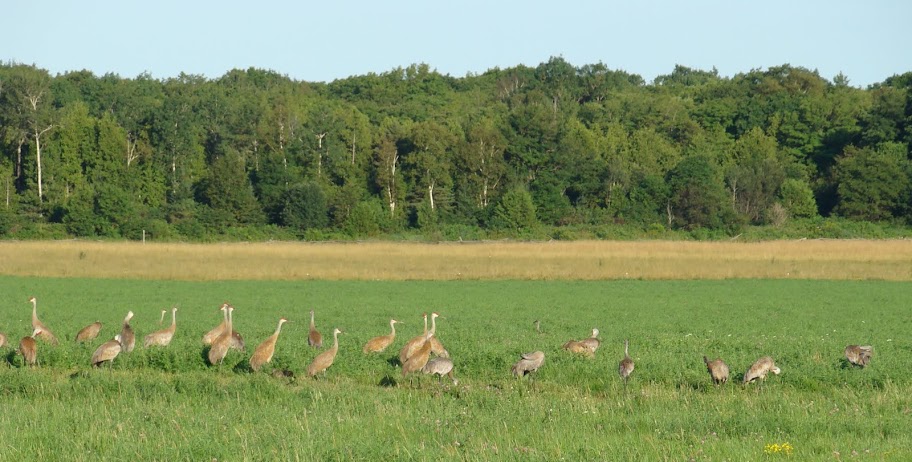 |
| A Sandhill Crane flock in Hay-field |
Now if we look at the history of Sandhill Cranes, they were driven to near-extinction by habitat destruction for agriculture and urbanization, and hunting. In the past, though, they sprung back and are not threatened anymore. In the present, their populations are stable, but what if they go up in the future? Is hunting a solution? Or should we change the way we farm, in order to minimize the loss? Thereby living sustainably, for once! These questions will be answered in the project I worked for. I was more than just glad to be a part of it. I will possibly be able to share the report in a few years.
To learn more about the technical work for the Sandhill Cranes project, and to get a glimpse at the flora and fauna of Manitoulin Island, visit my online slideshow below:
To say that studying wildlife does not constitute environmental studies is the height of aloofness. Why does every field of science need to be segmented into little boxes, one of which to we are tethered.
ReplyDelete"Is education possibly a process of trading awareness for things of lesser worth? The goose who trades his is soon a pile of feathers." --Aldo Leopold
Thanks for reading, Scienceguy. Education gets divided as the market for jobs gets more and more exclusive.
ReplyDeleteLoved reading your work… and wow! the photographs you captured! Amazing! Thanks for sharing :) Christine (Silver Water -Manitoulin Island).
ReplyDelete